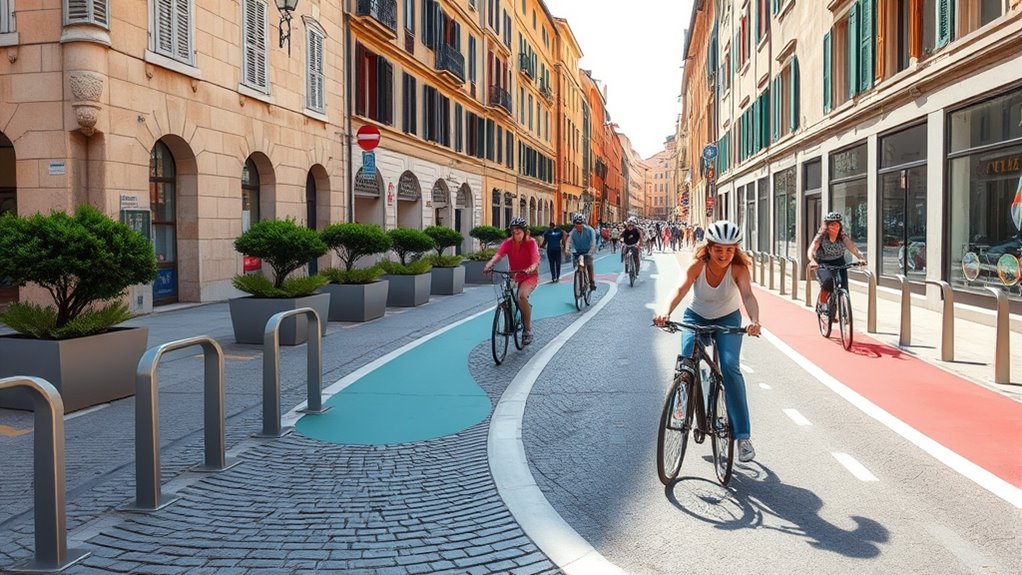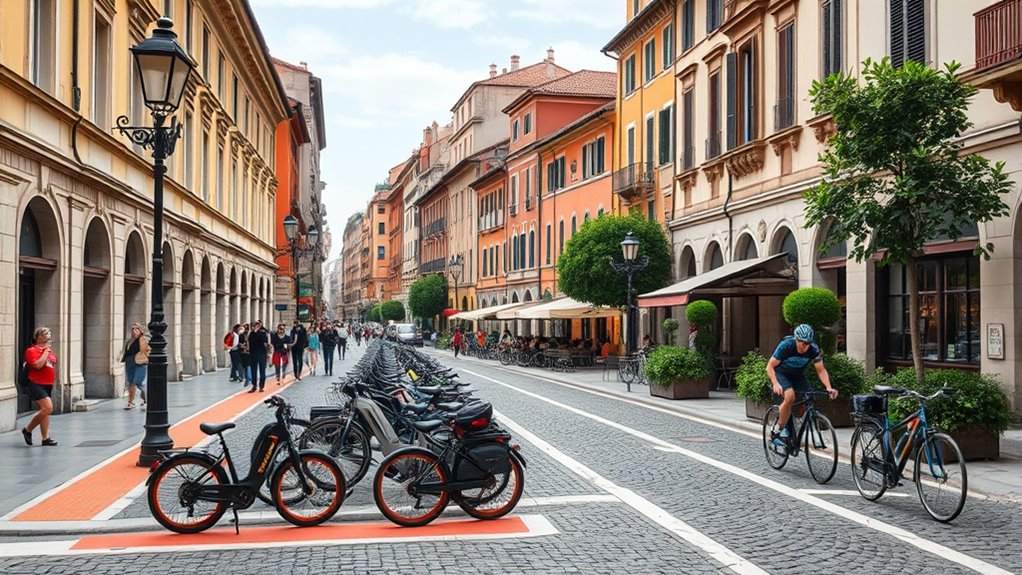In Italian cities, you can expect a big push toward expanding cycling infrastructure with more bike lanes, safer routes, and better integration with public transport. Cities are redesigning streets to include wider lanes, buffer zones, and physical barriers to protect cyclists. They’re also boosting bike-sharing schemes and parking facilities for added convenience. These improvements aim to make cycling safer, easier, and more appealing. Keep exploring to discover how these developments can transform your urban experience.
Key Takeaways
- Italian cities are expanding dedicated, safer bike lanes with physical barriers and wider lanes for improved cyclist safety.
- Local governments are investing in cycling-friendly policies, including protected intersections and bike parking facilities.
- Infrastructure improvements aim to make cycling more predictable, comfortable, and accessible for all users.
- Seamless integration of bike lanes with public transport hubs and bike-sharing schemes enhances multi-modal travel options.
- The overall goal is to reduce congestion and pollution while promoting cycling as a practical urban mobility solution.

Italian cities are increasingly prioritizing cycling infrastructure as a sustainable way to reduce traffic congestion and pollution. This shift is evident through extensive bike lane expansion projects across major urban areas. City planners recognize that creating safer, more connected cycling networks encourages residents to choose bikes over cars, helping to cut emissions and ease traffic jams. As you navigate these cities, you’ll notice a growing number of dedicated bike lanes that weave through busy streets, offering safer routes for cyclists and making cycling a practical alternative for daily commutes. These improvements often include dedicated bike lane designs that cater specifically to cyclist safety and comfort.
Urban cycling policies are at the core of this transformation. Local governments are implementing measures that promote biking as a key component of urban mobility. These policies often include dedicated funding for bike lane expansion, incentives for cyclists, and regulations that prioritize cycling safety. You’ll see signs of these policies in the form of protected bike lanes, bike-friendly intersections, and parking facilities that cater specifically to cyclists. Such initiatives aim not only to improve safety but also to normalize cycling as a convenient, everyday mode of transport.
Local governments promote cycling through dedicated funding, safety regulations, protected lanes, and bike-friendly infrastructure.
The expansion of bike lanes is more than just adding paint on the pavement; it involves rethinking city layouts to accommodate bicycles safely alongside vehicular traffic. Many cities are redesigning streets to include wider lanes, buffer zones, and physical barriers that separate cyclists from cars. This makes cycling feel less risky and more accessible, especially for newcomers or those commuting during busy hours. As you ride, you’ll likely notice how these improvements make your journey smoother and more predictable, fostering a sense of security that encourages more people to hop on their bikes.
Urban cycling policies also focus on integrating cycling into the broader transportation network. This means creating seamless connections between bike lanes, public transport hubs, and pedestrian zones. Such integration allows you to combine cycling with trains or buses, making your overall trip more efficient. Cities are installing bike racks at stations, launching bike-sharing schemes, and developing infrastructure that supports multi-modal travel. This extensive approach aims to make cycling not only a healthy choice but also a practical, everyday option for all residents.
Frequently Asked Questions
How Do Italian Cities Compare in Cycling Infrastructure With Other European Cities?
When comparing Italian cities’ cycling infrastructure to other European ones, you’ll notice varied progress. Urban planning influences cyclist safety profoundly, with some Italian cities investing more in dedicated bike lanes and traffic calming. While cities like Copenhagen excel, Italian cities are catching up, but you might still encounter limited infrastructure. Your experience depends on local policies, but overall, Italy is steadily improving its commitment to safer, more accessible cycling environments.
Are There Specific Safety Regulations for Cyclists in Italy?
Think of Italy’s cycling safety regulations as a well-choreographed dance, guiding your every move. You’ll find specific bike regulations that emphasize wearing helmets, respecting traffic signals, and using designated bike lanes. These rules aim to guarantee your safety as a cyclist. By following Italy’s bike regulations, you contribute to a safer environment for everyone on the road, making your riding experience both enjoyable and secure.
What Are the Most Bike-Friendly Italian Cities to Visit?
You’ll find that cities like Bologna, Milan, and Florence are among the most bike-friendly in Italy. They’ve expanded bike lanes to support cycling tourism, making it easier and safer for you to explore. Expect well-maintained paths, bike-sharing programs, and scenic routes. These cities actively promote cycling, so you can enjoy a more eco-friendly and authentic experience while riding through historic streets and vibrant neighborhoods.
How Is Cycling Infrastructure Funded and Maintained in Italy?
You’ll find that cycling infrastructure in Italy is mainly funded through public-private partnerships and urban planning strategies. These collaborations help build and maintain bike lanes, ensuring safety and accessibility. Local governments prioritize sustainable transportation, often investing in bike-friendly initiatives. By supporting these efforts, they aim to promote cycling as a convenient, eco-friendly option for residents and visitors alike. This approach keeps infrastructure well-maintained and integrated into city planning.
Are There Any Upcoming Developments or Projects for Cycling Infrastructure?
You’ll be pleased to know that Italy’s government initiatives are driving exciting future projects for cycling infrastructure. Currently, over 30% of Italian cities plan to expand their bike lanes in the next five years. These developments aim to promote sustainable transportation and reduce congestion. Stay tuned, as upcoming projects include dedicated bike routes and improved safety measures, reflecting Italy’s commitment to making cycling safer and more accessible for everyone.
Conclusion
As you explore Italy’s cities, remember that building cycling infrastructure is like planting seeds—each new bike lane or path helps grow a more vibrant, sustainable future. Imagine a cyclist weaving smoothly through a newly completed network, feeling the wind and freedom—proof that your support can turn these plans into reality. With every effort, you’re helping create a city where everyone can ride safely and joyfully, transforming urban life one pedal stroke at a time.









